Note
This page was generated from enrichment.ipynb. Some tutorial content may look better in light mode.
Enrichment¶
Gene set enrichment analysis allows for the determination of gene sets that are significantly upregulated or downregulated in one population compared to another, providing insights into cellular functions and disease mechanisms. It is typically performed by aggregating differential expression results across cells, then using statistical methods to determine if specific sets of genes are disproportionately represented among the differentially expressed genes.
Although commonly done for pathways, any gene set can be tested for enrichment. Pertpy offers rich access to metadata which we can leverage for this purpose. Here, we’ll reproduce drug2cell where we’ll enrich cells using the chEMBL database which contains bioactive molecules with drug-like properties and their corresponding gene sets.
Setup¶
We’ll be using the standard processed pbmc3k dataset from scanpy.
[1]:
import warnings
warnings.filterwarnings("ignore")
[2]:
import pertpy as pt
import scanpy as sc
adata = sc.datasets.pbmc3k_processed()
[3]:
adata
[3]:
AnnData object with n_obs × n_vars = 2638 × 1838
obs: 'n_genes', 'percent_mito', 'n_counts', 'louvain'
var: 'n_cells'
uns: 'draw_graph', 'louvain', 'louvain_colors', 'neighbors', 'pca', 'rank_genes_groups'
obsm: 'X_pca', 'X_tsne', 'X_umap', 'X_draw_graph_fr'
varm: 'PCs'
obsp: 'distances', 'connectivities'
Fetching chEMBL metadata¶
As a (currently optional!) step we will fetch the chEMBL metadata and examine it:
[4]:
pt_chembl = pt.md.Drug()
[5]:
pt_chembl.annotate(adata)
[5]:
AnnData object with n_obs × n_vars = 2638 × 1838
obs: 'n_genes', 'percent_mito', 'n_counts', 'louvain'
var: 'n_cells', 'compounds'
uns: 'draw_graph', 'louvain', 'louvain_colors', 'neighbors', 'pca', 'rank_genes_groups'
obsm: 'X_pca', 'X_tsne', 'X_umap', 'X_draw_graph_fr'
varm: 'PCs'
obsp: 'distances', 'connectivities'
[6]:
non_empty_compounds = adata.var["compounds"][adata.var["compounds"] != ""]
non_empty_compounds
[6]:
index
CDA CHEMBL3237547|CEDAZURIDINE
HDAC1 CHEMBL343448|ROMIDEPSIN|CHEMBL3545368|PANOBINO...
FAAH CHEMBL112|ACETAMINOPHEN
PKN2 CHEMBL1421|DASATINIB|CHEMBL1983268|ENTRECTINIB...
CD2 CHEMBL1201571|ALEFACEPT
...
C5AR1 CHEMBL3989871|AVACOPAN
FPR1 CHEMBL101|PHENYLBUTAZONE|CHEMBL1223|PENICILLIN...
APOBEC3A CHEMBL474579|CEFOTETAN
APOBEC3G CHEMBL474579|CEFOTETAN
TYMP CHEMBL65375|TIPIRACIL HYDROCHLORIDE
Name: compounds, Length: 94, dtype: object
94 of the genes are included in one or several (divided by the ‘|’ character) gene sets of the chEMBL database.
But are any of these associations statistically significant? Let’s test this with a hypergeometric test. As a first step, we’ll score the genes which computes the mean gene expression of each gene group per cell.
Scoring gene sets¶
[7]:
pt_enricher = pt.tl.Enrichment()
pt_enricher.score(adata)
This added several new keys in uns such as the pertpy_enrichment_score:
[8]:
adata.uns["pertpy_enrichment_score"]
[8]:
array([[-0.23824894, -0.17137621, -0.17137621, ..., -0.24132079,
-0.12806633, -0.17137621],
[-0.30187321, -0.22021136, -0.22021136, ..., -0.05865689,
-0.21009679, -0.22021136],
[-0.3140685 , -0.21615721, -0.21615721, ..., -0.10235345,
-0.09656522, -0.21615721],
...,
[-0.23376985, -0.16457197, -0.16457197, ..., -0.27393138,
-0.0898563 , -0.16457197],
[-0.21525031, -0.15072401, -0.15072401, ..., -0.32494837,
-0.06951345, -0.15072401],
[-0.2774846 , -0.18967144, -0.18967144, ..., -0.19803014,
-0.0647603 , -0.18967144]])
Let’s calculate the differentially expressed genes using a simple Wilcoxon test:
[9]:
sc.tl.rank_genes_groups(adata, method="wilcoxon", groupby="louvain")
It’s possible to subset the drug space based on their ATC level 1 and 2 categories for more fine-grained plots:
[10]:
pt_enricher.plot_dotplot(adata, categories=["B01", "B02", "B03"], groupby="louvain")
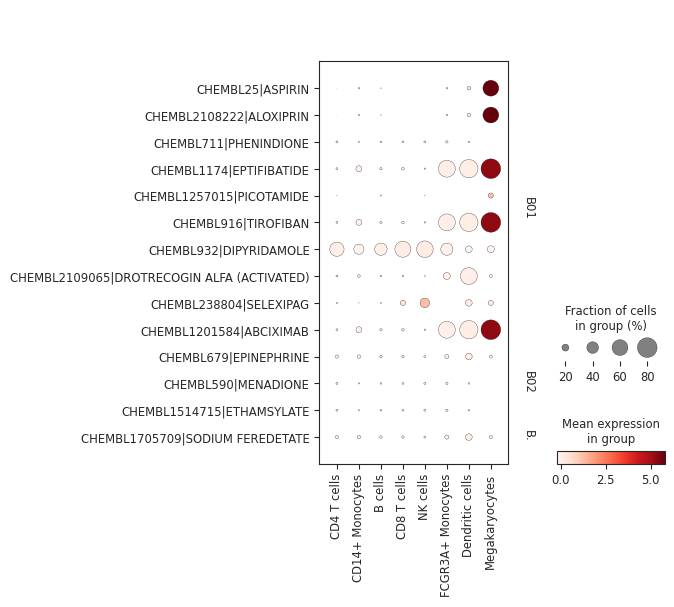
Hypergeometric test¶
We can now apply pertpy’s hypergeometric test to test for significance. By default, it uses the scoring output, but it can also be used with custom targets that can be passed. The output is a dictionary of DataFrames with the clusters used to compute the markers in the original expression space as the keys.
[11]:
overrepresentation = pt_enricher.hypergeometric(adata)
[12]:
overrepresentation["B cells"]
[12]:
| intersection | gene_group | markers | universe | pvals | pvals_adj | |
|---|---|---|---|---|---|---|
| CHEMBL1261|CITRIC ACID | 0 | 1 | 695 | 1838 | 1.0 | 1.0 |
| CHEMBL1021|NEPAFENAC | 0 | 1 | 695 | 1838 | 1.0 | 1.0 |
| CHEMBL19|METHAZOLAMIDE | 0 | 2 | 695 | 1838 | 1.0 | 1.0 |
| CHEMBL1200865|LOTEPREDNOL ETABONATE | 0 | 1 | 695 | 1838 | 1.0 | 1.0 |
| CHEMBL220491|BRINZOLAMIDE | 0 | 1 | 695 | 1838 | 1.0 | 1.0 |
| ... | ... | ... | ... | ... | ... | ... |
| CHEMBL956|SUPROFEN | 0 | 1 | 695 | 1838 | 1.0 | 1.0 |
| CHEMBL118|CELECOXIB | 0 | 2 | 695 | 1838 | 1.0 | 1.0 |
| CHEMBL340978|BENOXAPROFEN | 0 | 1 | 695 | 1838 | 1.0 | 1.0 |
| CHEMBL1565476|APAZONE | 0 | 2 | 695 | 1838 | 1.0 | 1.0 |
| CHEMBL1200467|HYDROXYZINE PAMOATE | 0 | 1 | 695 | 1838 | 1.0 | 1.0 |
601 rows × 6 columns
Pertpy provides a GSEA (gene set enrichment analysis) wrapper, executed through blitzgsea. Unlike standard overrepresentation testing, GSEA evaluates gene sets based on their marker scores and assesses the distribution of the gene group members.
[13]:
enrichment = pt_enricher.gsea(adata)
[14]:
pt_enricher.plot_gsea(adata, enrichment, interactive_plot=True)
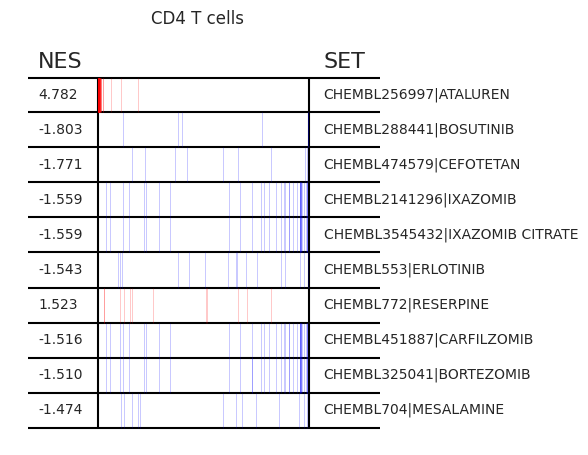
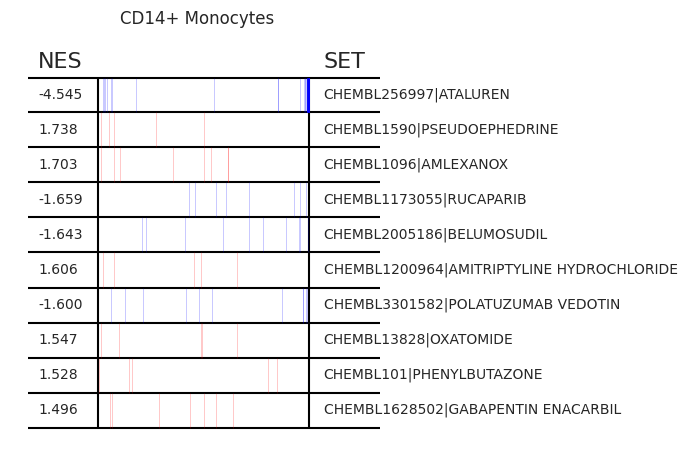
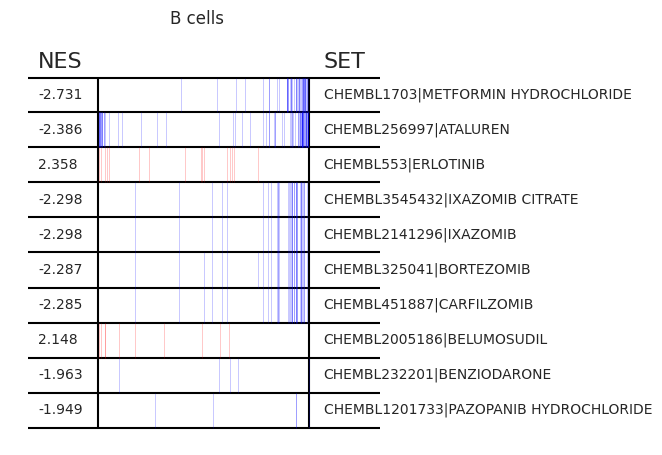
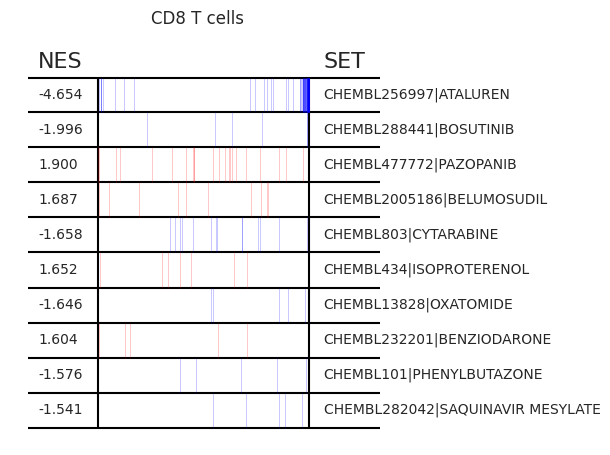
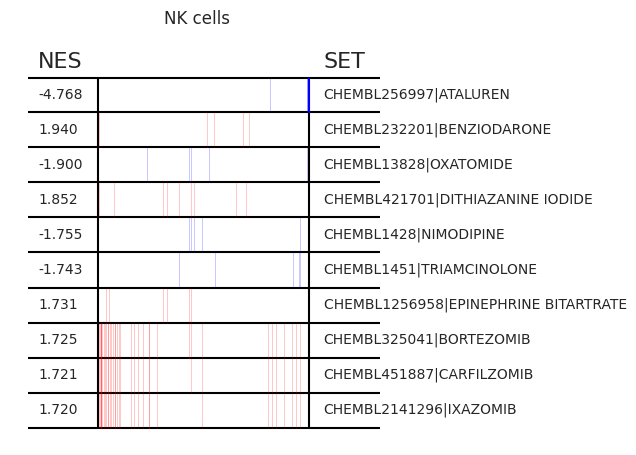
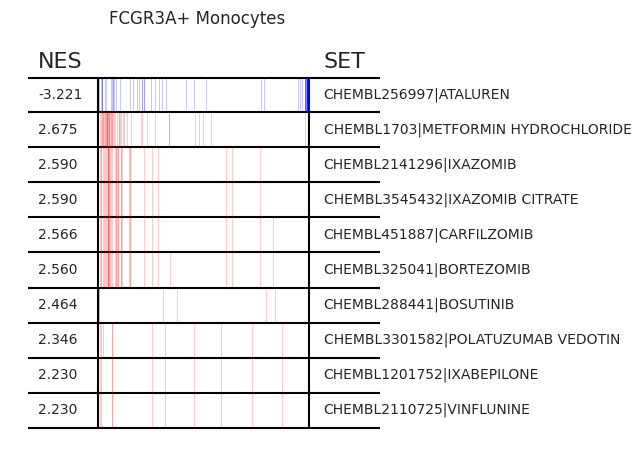
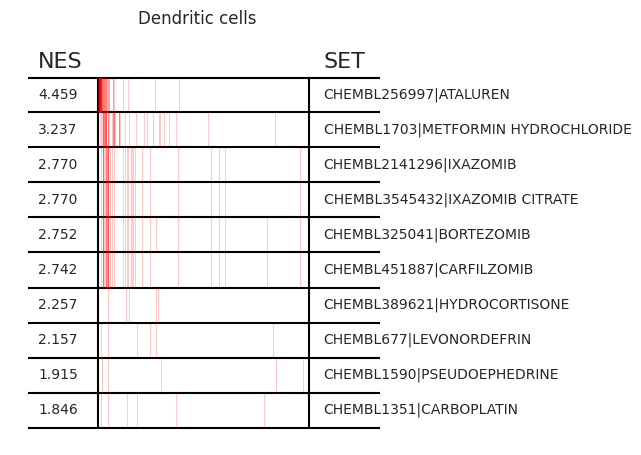

Using custom gene sets¶
By default, the score function uses the chEMBL dataset, but other it is possible to score any gene sets of choice. The input takes the form of a dictionary with group names as keys and corresponding gene sets as values.
[15]:
import blitzgsea as blitz
targets = blitz.enrichr.get_library("GO_Molecular_Function_2021")
targets["MHC class II receptor activity (GO:0032395)"]
[15]:
['HLA-DPA1',
'HLA-DQB1',
'HLA-DRA',
'HLA-DOB',
'HLA-DRB3',
'HLA-DQA2',
'HLA-DOA',
'HLA-DQA1',
'HLA-DQB2',
'HLA-DRB1']
We can pass these gene sets to the score function’s targets parameter:
[16]:
pt_enricher.score(adata, targets=targets)
[17]:
enrichment = pt_enricher.gsea(adata, targets=targets)
[18]:
fig = blitz.plot.running_sum(
signature=adata.uns["pertpy_enrichment_gsea"]["scores"]["B cells"],
library=adata.uns["pertpy_enrichment_gsea"]["targets"],
result=enrichment["B cells"],
geneset="MHC class II receptor activity (GO:0032395)",
interactive_plot=True,
)
fig.show()
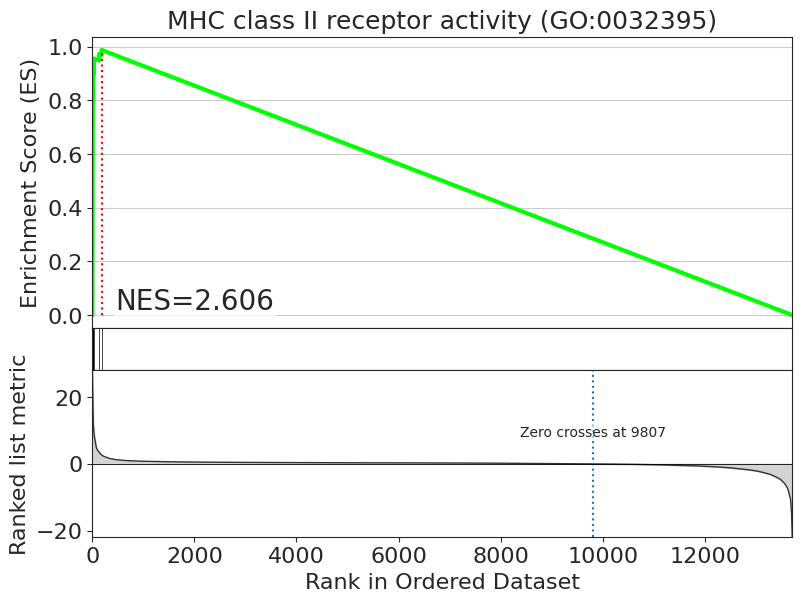
Conclusion¶
Pertpy enables gene set enrichment analysis using the metadata in pertpy such as the chEMBL database to identify significant gene sets affected by bioactive molecules in different cell populations.
References¶
Kanemaru, K., Cranley, J., Muraro, D. et al. Spatially resolved multiomics of human cardiac niches. Nature 619, 801–810 (2023). https://doi.org/10.1038/s41586-023-06311-1